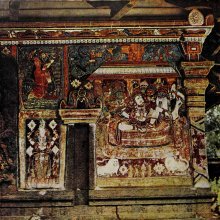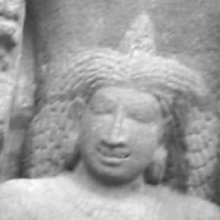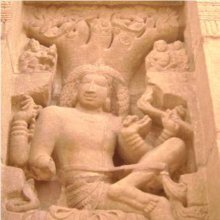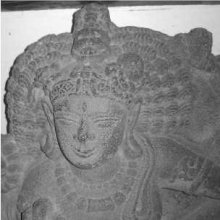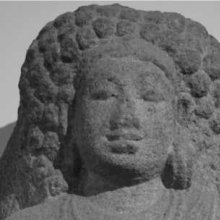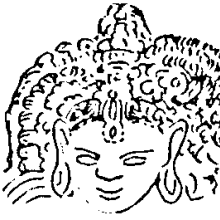Dakshinamurti, Dakṣiṇāmūrti, Dakshina-murti: 16 definitions
Introduction:
Dakshinamurti means something in Hinduism, Sanskrit, the history of ancient India. If you want to know the exact meaning, history, etymology or English translation of this term then check out the descriptions on this page. Add your comment or reference to a book if you want to contribute to this summary article.
The Sanskrit term Dakṣiṇāmūrti can be transliterated into English as Daksinamurti or Dakshinamurti, using the IAST transliteration scheme (?).
Images (photo gallery)
(+9 more images available)
In Hinduism
Shaivism (Shaiva philosophy)
Source: Manblunder: Sri Rudram 2.7-13Dakṣiṇāmūrti (दक्षिणामूर्ति), one of the forms of Shiva is the author of many mantras.
Source: Manblunder: Sri Rudram 2.1-2Dakṣiṇāmūrti (दक्षिणामूर्ति):—Sanaka, Sana, Sanatkumāra, and Sanāndana are the four great sages who were initiated by Dakṣiṇāmūrti. There was a huge banyan tree under which was seated young Dakṣiṇāmūrti with his aged disciples mentioned above. The banyan tree is the symbolic manifestation of macrocosm from microcosm. From a tiny seed of banyan, a huge tree of banyan grows. This is compared to the formation of gross from subtle. Initiation takes place without any words being exchanged.
Source: Shodhganga: Iconographical representations of Śiva1) Dakṣiṇāmūrti (दक्षिणामूर्ति) or simply Dakṣiṇā refers to one of the twenty-three forms (mūrti) of Śiva mentioned in the Pūrvakāmikāgama (pratimālakṣaṇavidhi-paṭala): first and foremost among the Mūlāgama. The forms of Śiva (e.g., Dakṣiṇā-mūrti) are established through a process known as Sādākhya, described as a five-fold process of creation.
2) Dakṣiṇāmūrti is also listed among the twenty-eighth forms (mūrti) of Śiva mentioned in the Vātulāgama: twenty-eighth among the Siddhāntaśaivāgama.
3) Dakṣiṇāmūrti is also listed among the eighteen forms (mūrti) of Śiva mentioned in the Kāraṇāgama (pratimālakṣaṇavidhi-paṭala): the fourth among the Siddhāntaśaivāgamas.
4) Dakṣiṇāmūrti is also listed among the ten forms (mūrti) of Śiva mentioned in the Ajitāgama (under the Raudrarūpa heading): the fifth among the Siddhāntaśaivāgamas.
5) Dakṣiṇāmūrti is also listed among the sixteen forms (mūrti) of Śiva mentioned in the Dīptāgama: the sixth among the Siddhāntaśaivāgamas.
6) Dakṣiṇāmūrti is also listed among the eighteen forms (mūrti) of Śiva mentioned in the Śilparatna (twenty-second adhyāya): a technical treatise by Śrīkumāra on Śilpaśāstra.
Source: Shodhganga: The significance of the mūla-beras (shaivism)Dakṣiṇāmūrti refers to one of the manifestations of Śiva.—The image of Dakṣiṇāmūrti in Jambukeśvara Temple brings out the infinite wisdom imbibed within the Lord. On seeing the face and eyes of the deity, the perceiver feels calm and relaxed, and perceives the light that is radiated in the eyes of the deity. He experiences the yogic state.

Shaiva (शैव, śaiva) or Shaivism (śaivism) represents a tradition of Hinduism worshiping Shiva as the supreme being. Closely related to Shaktism, Shaiva literature includes a range of scriptures, including Tantras, while the root of this tradition may be traced back to the ancient Vedas.
Shilpashastra (iconography)
Source: Wisdom Library: Śilpa-śāstraDakṣiṇāmūrti (दक्षिणामूर्ति) refers to “knowledge aspects”. It is one of the five classes of śivamūrti (‘image of Śiva’).
Dakṣiṇāmūrti refers to an image (mūrti) of an aspect of Śiva. Dakṣiṇā literally means “facing south”. The Pūrva-kāraṇāgama states that the figures of Śiva in the dakṣiṇā-mūrti aspect should not have near them the figure of the Devi. The colour, according to the Kāraṇāgama, of the dakṣiṇā-mūrti aspect of Śiva is to be white.
Source: Shodhganga: The significance of the mūla-beras (śilpa)Dakṣiṇāmūrti (दक्षिणामूर्ति) is a form of Śiva. He is called Mahā Yogi (the great ascetic) and is seated on a tiger’s skin. Dakṣiṇāmūrti is found seated in vīrāsana usually under a tree with disciples around him. He is found with four hands. The upper right hand carries the rosary in kaṭaka-hasta and the upper left hand holds the agni (fire) in kaṭaka-hasta. The rosary signifies the ṛṣi state of the lord chanting the prayers and the mantras. The agni symbolizes the destruction of the evil within oneself and the destruction of the enemies around. The agni also stands for removing the ignorance and shedding light in the minds of the devotees. The lower right hand is in the upadeśa pose in vyākyāna-mudrā which symbolizes the lord as the teacher of truth, moral values and good activities. The lower left hand holds the Vedas or pustaka (book) in siṃhakarṇa/vismaya. This represents that the lord teaches the Vedas to his devotees.
The image of Dakṣiṇāmūrti is the embodiment of wisdom, tranquility and serenity. His plentiful hair falls over his shoulders. As a guru, he teaches his doctrines to his disciples who are collected round him.
Dakṣiṇāmūrti is found depicted in various temples:
The Aruṇācaleśvar or Arunachaleswara Temple in Thiruvannamalai (Tiruvaṇṇāmalai), [Śiva temple].—Dakṣiṇāmūrti is represented seated on a tiger’s skin in the position called vīrāsana (left leg folded and right leg hanging down below the seat). [...] While depicting in Bharatanatyam, Dakṣiṇāmūrti is represented in aindra-maṇḍala or ekapāda in araimandi.
The Jambukeswarar Temple in Tiruvānaikoyil (Thiruvanaikaval), [another Śiva temple].—In this sannidhi, [Dakṣiṇāmūrti] is found with the same attributes as mentioned earlier. His plentiful hair falls over his shoulders. As a Guru, he teaches his doctrines to his disciples who are collected round him. The dance postures are also the same as discussed earlier.

Shilpashastra (शिल्पशास्त्र, śilpaśāstra) represents the ancient Indian science (shastra) of creative arts (shilpa) such as sculpture, iconography and painting. Closely related to Vastushastra (architecture), they often share the same literature.
Vastushastra (architecture)
Source: Shodhganga: Temples of Salem region Up to 1336 ADDakṣiṇāmūrti (दक्षिणामूर्ति) is a form of Śiva, which is found invariability in almost all the Śaiva temples of Tamilnadu. Shiva, in this form, is depicted as the “Guru who guides his devotes in the right path (dakṣiṇāmārga)” and hence called by this name. The images generally are housed inside the koṣṭas in the southern wall of the shrine, as per the prescription of the Texts.
In this form, Śiva is represented as seated on a rock in lalitāsana. His right hand is in vyākhyānamudra. Other hands hold sarpa, agni and akṣamāla. The four sages (Sanaka, Sanandana, Sanatkumara and Sanatsujata) are represented as seated on the foreground. The height of these images varies from one and a half feet to four feet.

Vastushastra (वास्तुशास्त्र, vāstuśāstra) refers to the ancient Indian science (shastra) of architecture (vastu), dealing with topics such architecture, sculpture, town-building, fort building and various other constructions. Vastu also deals with the philosophy of the architectural relation with the cosmic universe.
Purana and Itihasa (epic history)
Source: archive.org: Shiva Purana - English TranslationDakṣiṇāmūrti (दक्षिणामूर्ति) refers to a form of Rudra, according to the Śivapurāṇa 2.5.6 (“Prayer to Śiva”).—Accordingly, as Sanatkumāra narrated to Vyāsa: “[...] After eulogising lord Śiva thus and prostrating at length, he repeated the mantra of Dakṣiṇāmūrti Rudra. He repeated the mantra fifteen million times standing in water and concentrating his mind on him. Lord Viṣṇu meditated on the great lord Śiva. In the meantime, the gods too eulogised him with devotion. [...]”.

The Purana (पुराण, purāṇas) refers to Sanskrit literature preserving ancient India’s vast cultural history, including historical legends, religious ceremonies, various arts and sciences. The eighteen mahapuranas total over 400,000 shlokas (metrical couplets) and date to at least several centuries BCE.
General definition (in Hinduism)
Source: Red Zambla: Dakshinamurthy Stotram by Shankara-acharyaThe word “Dakṣiṇāmūrti” is a composite word consisting of 2 parts; it can be understood two-fold:
1. Dakṣiṇā Mūrti - One whose Mūrti (form) is facing South. This is Here Dakṣiṇā means south.
2. Dakshin Amurti - One who is Dakshin and also Amurti (both adjectives). One who is skilful and formless. Here Dakshiṇā means Skilful, Skilful in removing the ignorance.
Source: South Asian Studies: Volume 27, Issue 2, 2011Dakṣiṇāmūrti is a Śaivite iconographical form which appears in Indian art from the later Pallava period onwards. It was a stereotyped installation on the southern devakoṣṭha in any Śiva temple from the early Cōḻa period. Deviating from this established pattern, some of the Viṣṇu temples, called Navatiruppatis, on both banks of the River Tāmiraparaṇi in the Far South of India have these images installed on the devakoṣṭhas, grīvakoṣṭhas, and talas of the vimānas in Viṣṇu temples.
India history and geography
Source: Cologne Digital Sanskrit Dictionaries: Indian Epigraphical GlossaryDakṣiṇāmūrti.—(SII 12), an aspect of Śiva. Note: dakṣiṇāmūrti is defined in the “Indian epigraphical glossary” as it can be found on ancient inscriptions commonly written in Sanskrit, Prakrit or Dravidian languages.

The history of India traces the identification of countries, villages, towns and other regions of India, as well as mythology, zoology, royal dynasties, rulers, tribes, local festivities and traditions and regional languages. Ancient India enjoyed religious freedom and encourages the path of Dharma, a concept common to Buddhism, Hinduism, and Jainism.
Languages of India and abroad
Sanskrit dictionary
Source: DDSA: The practical Sanskrit-English dictionaryDakṣiṇāmūrti (दक्षिणामूर्ति).—m. a Tāntric form of Śiva.
Derivable forms: dakṣiṇāmūrtiḥ (दक्षिणामूर्तिः).
Dakṣiṇāmūrti is a Sanskrit compound consisting of the terms dakṣiṇā and mūrti (मूर्ति).
Source: Cologne Digital Sanskrit Dictionaries: Aufrecht Catalogus Catalogorum1) Dakṣiṇāmūrti (दक्षिणामूर्ति) as mentioned in Aufrecht’s Catalogus Catalogorum:—[tantric] Pheh. 15 (and—[commentary]).
2) Dakṣiṇāmūrti (दक्षिणामूर्ति):—Bījakośa [tantric] B. 4, 260. Bījakośoddhāra. H. 164. Mantroddhārakośa or Mantrakośa or Uddhārakośa.
3) Dakṣiṇāmūrti (दक्षिणामूर्ति):—Lokoktimuktāvalī.
Source: Cologne Digital Sanskrit Dictionaries: Monier-Williams Sanskrit-English Dictionary1) Dakṣiṇāmūrti (दक्षिणामूर्ति):—[=dakṣiṇā-mūrti] [from dakṣiṇā > dakṣ] m. a Tāntric form of Śiva
2) [v.s. ...] Name of a copyist of the 17th cent.
[Sanskrit to German]
Sanskrit, also spelled संस्कृतम् (saṃskṛtam), is an ancient language of India commonly seen as the grandmother of the Indo-European language family (even English!). Closely allied with Prakrit and Pali, Sanskrit is more exhaustive in both grammar and terms and has the most extensive collection of literature in the world, greatly surpassing its sister-languages Greek and Latin.
See also (Relevant definitions)
Partial matches: Dakshina, Murti.
Starts with (+3): Dakshinamurtibhait, Dakshinamurticandrika, Dakshinamurtikalpa, Dakshinamurtikavaca, Dakshinamurtimanasapuja, Dakshinamurtimanasollasa, Dakshinamurtimantra, Dakshinamurtimantrarnava, Dakshinamurtinyasa, Dakshinamurtipaddhati, Dakshinamurtipanjara, Dakshinamurtipatala, Dakshinamurtiprakarana, Dakshinamurtipratishtha, Dakshinamurtiprayoga, Dakshinamurtisahasranaman, Dakshinamurtisahastranaman, Dakshinamurtisamhita, Dakshinamurtistava, Dakshinamurtistotra.
Full-text (+49): Dakshinamurtimantra, Dakshinamurtiprayoga, Dakshinamurtisamhita, Dakshinamurtistava, Dakshinamurtistotra, Jatabhara, Dakshinamurtyupanishad, Takshinamurtti, Uddharakosha, Yokatakshinamurttam, Al-amarkatavul, Lokoktimuktavali, Dakshinamnaya, Mantroddharakosha, Metamanu, Dakshinamurtipratishtha, Venkateshvara, Shivamurti, Venkateshvara kaundinya, Mahavidya.
Relevant text
Search found 29 books and stories containing Dakshinamurti, Dakṣiṇāmūrti, Dakshina-murti, Dakṣiṇā-mūrti, Daksinamurti, Daksina-murti; (plurals include: Dakshinamurtis, Dakṣiṇāmūrtis, murtis, mūrtis, Daksinamurtis). You can also click to the full overview containing English textual excerpts. Below are direct links for the most relevant articles:
Later Chola Temples (by S. R. Balasubrahmanyam)
Temples in Tiruvanchiyam (Srivanchiyam) < [Chapter VIII - Temples of Rajaraja II’s Time]
Temples in Trisulam < [Chapter II - Temples of Kulottunga I’s Time]
Temples in Achyutamangalam < [Chapter XII - Temples of Kulottunga III’s Time]
Middle Chola Temples (by S. R. Balasubrahmanyam)
Temples in Esalam < [Chapter II - Temples of Rajaraja I’s Time]
Temples in Marakkanam < [Chapter II - Temples of Rajaraja I’s Time]
Temples in Kalakattur < [Chapter II - Temples of Rajaraja I’s Time]
The Religion and Philosophy of Tevaram (Thevaram) (by M. A. Dorai Rangaswamy)
Chapter 4.2 - Dakshinamurti < [Volume 2 - Nampi Arurar and Mythology]
Introduction to second volume < [Volume 2 - Nampi Arurar and Mythology]
Chapter 1.1 - Arurar’s Language of Mythology < [Volume 2 - Nampi Arurar and Mythology]
Early Chola Temples (by S. R. Balasubrahmanyam)
Temples in Gramam (36th year) < [Chapter X - Historical Survey]
Temples in Tirunamanallur (or Tirunavalur) (28th year) < [Chapter X - Historical Survey]
Temples in Pullamangai (near Pasupatikoyil) (3rd to 6th year) < [Chapter X - Historical Survey]
Lakulisha-Pashupata (Philosophy and Practice) (by Geetika Kaw Kher)
Guru: The divine preceptor < [Chapter 3 - The Ritualistic Context]
Vyakhyana Daksinamurti < [Chapter 3 - The Ritualistic Context]
Historicity (of the term linga) < [Chapter 6 - Siva-linga: an Iconological Study]
Temples of Munnur (Historical Study) (by R. Muthuraman)
Images of Daksinamurti < [Chapter 5]
Introduction: The Sculpture Art of the Munnur Temples < [Chapter 5]
Adavalleswarar or Adavalleeswarar Temple (Architecture) < [Chapter 4]
Related products
